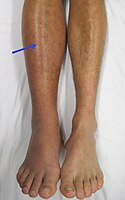
Photo from wikipedia
PURPOSE Ultrasonography is the primary imaging modality in pediatrics but still lacks sufficient reimbursement in Germany. In this multicenter study, national data for the duration of standard ultrasound in pediatrics… Click to show full abstract
PURPOSE Ultrasonography is the primary imaging modality in pediatrics but still lacks sufficient reimbursement in Germany. In this multicenter study, national data for the duration of standard ultrasound in pediatrics were systematically documented in order to specify the actual time required. MATERIALS AND METHODS N = 10 hospitals (N = 5 university hospitals, N = 5 non-university hospitals) and N = 3 medical practices in Germany recorded the entire process of an ultrasound examination in a special protocol developed by the Pediatric Section of the DEGUM. The duration of each of seven single steps during ultrasonography (from data input to final discussion of the results) of different organ systems was logged. RESULTS In total, N = 2118 examinations from different organ systems were recorded. N = 10 organ systems were examined frequently (> 30 times). The total duration of an ultrasound examination was statistically significantly longer in hospitals compared to medical practices (median (IQR) 27 min. (18-38) vs. 12 min. (9-17), p < 0.001). The "hands-on" patient time was approximately one half of the total required time in both settings (49.9 % vs. 48.9 %). Ultrasonography of the abdomen and brain lasted longer in university hospitals than in non-university hospitals (p < 0.001, and p = 0.04, respectively). Cooperation and age did not uniformly correlate with the total duration. CONCLUSION This study provides novel comprehensive national data for the duration of standardized ultrasound examinations of children and adolescents in Germany. These data are essential for a further evaluation of the economic costs and should support better remuneration in the future.
Journal Title: Ultraschall in der Medizin
Year Published: 2019
Link to full text (if available)
Share on Social Media: Sign Up to like & get
recommendations!